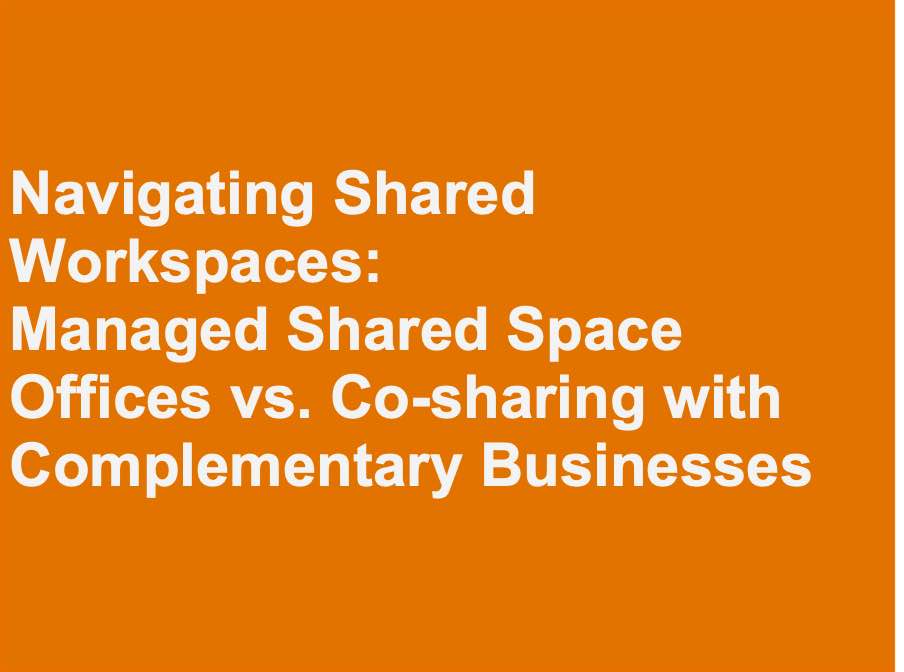Navigating Shared Workspaces: Managed Shared Space Offices vs. Co-sharing with Complementary Businesses
The contemporary business environment is dramatically shifting, with conventional office spaces rapidly making way for more flexible and cost-efficient options. Among the growing trends in the corporate world are managed shared space offices and the sharing of an exclusive office with one or two other complementary businesses. Both offer unique advantages and present distinct considerations for businesses. Here, we delve into each, comparing their benefits and challenges to help businesses make informed decisions.
Managed Shared Space Offices
Managed shared space offices, or coworking spaces, have gained significant popularity over the past decade, largely due to the rise of startups, freelancers, and remote work culture. These spaces offer a broad array of benefits:
1. Flexibility and Scalability: Shared spaces typically offer monthly memberships, allowing businesses to adjust their office space needs based on changes in their team size or financial resources.
2. Networking Opportunities: Being in an environment with various businesses and professionals can lead to networking and collaboration opportunities.
3. Amenities: Shared spaces often come fully equipped with business essentials such as high-speed internet, meeting rooms, and sometimes, recreational areas, taking the burden of infrastructure management off your shoulders.
4. Cost-effective: Overhead costs are significantly reduced as expenses like rent, utilities, and maintenance are shared among all members.
However, there are some considerations to take into account:
1. Limited Privacy: Shared spaces tend to lack privacy due to the communal nature of the environment, which may not suit all business types.
2. Less Brand Identity: In a managed shared space, it's challenging to establish a strong brand presence since the office setup and design are typically generic and cater to a wide variety of tenants.
There are some strategies to address the concerns about managed workspace environments:
Concern: Limited Privacy
1. Private Spaces: Opt for a shared office that offers private areas or meeting rooms that can be reserved as needed. This offers a balance between the collaborative environment and the necessary privacy for confidential discussions or focused work.
2. Clear Communication: Establish clear protocols and boundaries around noise levels, personal space, and use of communal areas to foster a respectful and less distracting environment.
Concern: Less Brand Identity
1. Personal Touches: While you may not be able to alter the office design significantly, adding small branded items such as logos, color schemes, or even branded stationery can subtly establish your brand identity.
2. Digital Presence: Amplify your brand through your digital presence. Leverage your website, social media, and email communications to reflect your company culture and values.
Sharing an Exclusive Office with Complementary Businesses
Sharing an office with one or two other businesses that complement your own presents a different set of advantages:
1. Synergy: When the cohabiting businesses are complementary, there's an opportunity for strategic partnerships, cross-promotion, and collaboration, leading to shared growth.
2. Shared Resources with Increased Privacy: While offering the cost benefits of shared resources, this setup often provides more privacy than a typical coworking space, ideal for businesses that need a balance of collaboration and confidentiality.
3. Enhanced Brand Identity: With fewer businesses, there's more opportunity to personalize the office space to reflect your brand identity. This can be especially important if hosting client meetings
Yet, this setup isn't devoid of challenges:
1. Limited Scalability: Given that the space is shared with a fixed number of businesses, there may be constraints on how much your business can expand within the existing office.
2. Conflict of Interests: Sharing an office with other businesses can sometimes lead to conflict, particularly if the businesses aren't as complimentary as initially thought.
Here are some strategies to address the concerns about exclusive workspace environments:
Concern: Limited Scalability
1. Flexible Leasing Terms: Opt for flexible leasing agreements that allow you to adjust your office space as your business grows. This could include the ability to lease additional rooms or to adjust the sharing ratio as necessary.
2. Virtual Expansion: Implement digital tools and remote work policies that allow for expansion without needing additional physical space.
Concern: Conflict of Interests
1. Clear Agreement: Create a clear, comprehensive agreement outlining each business's responsibilities, spaces, and expectations. This can prevent misunderstandings and provide a reference point for resolving any potential conflicts.
2. Regular Check-Ins: Schedule regular meetings with the other businesses to address any concerns, discuss operational issues, and explore further collaborative opportunities.
In conclusion, both managed shared space offices and sharing an office with one or two complementary businesses present distinct opportunities for businesses, particularly for startups and small to mid-sized firms. The decision largely depends on the specific needs of the business, including factors like growth projections, need for privacy, desire for networking opportunities, and the importance of brand identity. By considering these factors, businesses can select the office setup that best suits their evolving needs in today's dynamic business environment. While shared workspaces do present some challenges, effective planning and open communication can go a long way towards turning these challenges into opportunities for collaboration and growth. Each business must assess its unique needs and priorities to implement the most effective strategies within their chosen workspace arrangement.



Leave a Reply